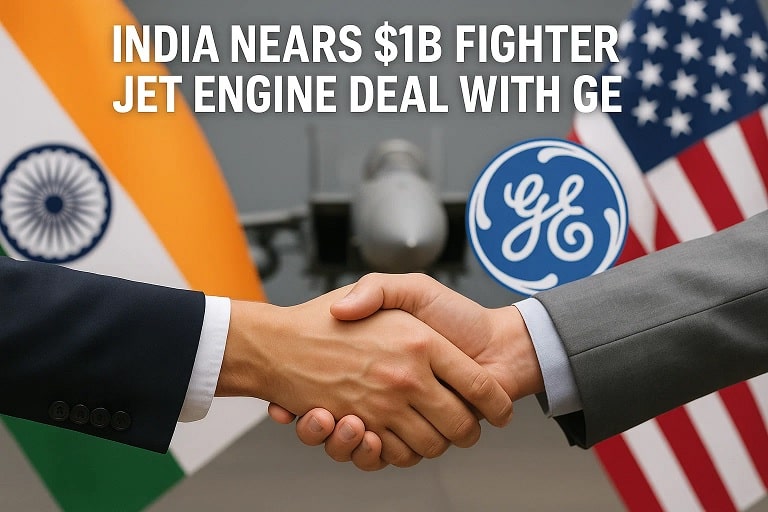India’s $1B GE Fighter Jet Engine Partnership
Overview of the Agreement
India is poised to finalize a pivotal $1 billion defense contract with General Electric (GE) Aerospace to acquire fighter jet engines for the Indian Air Force’s (IAF) Light Combat Aircraft (LCA) program. This agreement centers on supplying GE F404-IN20 engines for the LCA Mk1A variant, ensuring seamless production and advancing India’s goal of self-reliance in defense manufacturing. The deal is critical for modernizing India’s aging fighter fleet amid regional security challenges.
Evolution of the Partnership
Development Milestones
The collaboration between India and GE for fighter jet engines began with the Tejas LCA program. In 2021, Hindustan Aeronautics Limited (HAL) signed a $716 million contract for 99 F404 engines to power 83 LCA Mk1A aircraft. Supply chain issues caused delays, prompting India to pursue this additional $1 billion deal for more engines to sustain production. In early August 2025, India approved the acquisition of 97 additional LCA Mk1A fighters, further necessitating this engine procurement.
Strategic Significance
The LCA Mk1A is a cornerstone of India’s indigenous defense efforts, equipped with advanced radars, electronic warfare systems, and mid-air refueling capabilities. With the IAF’s fighter squadron strength at historic lows, this deal aims to boost operational readiness. It aligns with the ‘Make in India’ initiative, promoting local manufacturing and engaging small and medium enterprises in the defense sector.
Engine Procurement Specifics
Engine Type and Technical Details
The deal focuses on the GE F404-IN20 turbofan engine, a reliable afterburning engine designed for single-engine fighters like the LCA Mk1A. Key specifications include:
-
Thrust: Up to 84 kN (18,900 lbf) with afterburner.
-
Weight: Approximately 1,035 kg (dry).
-
Features: Full Authority Digital Electronic Control (FADEC), high reliability, and low maintenance needs.
-
Applications: Powers the Tejas Mk1 and Mk1A, enhancing maneuverability and payload capacity.
The F404-IN20 is tailored to meet India’s operational requirements.
Quantity and Financial Scope
-
Quantity: 113 additional F404-IN20 engines.
-
Value: Approximately $1 billion (USD).
-
Total Requirement: Combined with the previous 99 engines, this meets the need for around 212 engines to power all planned LCA Mk1A aircraft.
Key Stakeholders
-
Indian Side: Hindustan Aeronautics Limited (HAL) as the manufacturer, the Indian Air Force (IAF) as the end-user, and the Ministry of Defence overseeing approvals.
-
US Side: GE Aerospace, responsible for engine supply and technical support.
The deal has secured necessary approvals from US authorities, ensuring smooth execution.
Timeline of the Deal
The following table outlines key milestones in the India-GE F404 engine deal:
|
Milestone |
Date/Expected Date |
Description |
|---|---|---|
|
Initial Contract for 99 Engines |
August 2021 |
HAL signed a $716M deal for engines to power 83 LCA Mk1A. |
|
Supply Chain Resolution |
Mid-2025 |
GE resolved delays, committing to two engines per month. |
|
Approval for Additional LCA |
Early August 2025 |
Clearance for 97 more LCA Mk1A worth Rs 66,000 crore. |
|
Deal Signing |
By September 2025 |
Finalization of $1B contract for 113 engines. |
|
First Deliveries (Additional Engines) |
End of 2025 |
GE to deliver 12 engines by year-end, maintaining two per month. |
|
LCA Mk1A Delivery Completion |
2029-30 (First Batch), 2033-34 (Second Batch) |
HAL to supply all 180 LCA Mk1A to IAF. |
This timeline supports HAL’s target of producing 24 aircraft annually.
Benefits of the Deal
For India’s Defense Sector
-
Enhanced Self-Reliance: Secures engine supplies, reducing reliance on foreign imports.
-
Operational Boost: Equips the IAF with advanced fighters, improving air superiority with better endurance and weapon systems.
-
Economic Impact: Creates jobs and strengthens local industries through the defense supply chain.
Strategic Advantages
The deal enhances India’s deterrence capabilities amid regional tensions with neighboring countries. It also strengthens Indo-US defense ties, fostering future collaborations in aerospace technology.
Challenges and Risks
-
Past Delays: Supply chain disruptions previously delayed engine deliveries, though these have been addressed.
-
Geopolitical Factors: Potential changes in US policy, such as tariffs, could pose risks, but the deal is structured to remain resilient.
-
Technology Gaps: While this deal focuses on procurement, India continues to seek full technology transfer for indigenous engine development.
Parallel Engine Initiatives: The F414 Collaboration
India and GE are negotiating a separate deal for GE F414-INS6 engines, valued at over $1.5 billion, with 80% technology transfer for co-production in India. These engines will power the Tejas Mk2 and Advanced Medium Combat Aircraft (AMCA) prototypes.
Key Comparison: F404 vs F414 Engines
|
Feature |
GE F404-IN20 |
GE F414-INS6 |
|---|---|---|
|
Thrust |
84 kN |
98 kN |
|
Applications |
LCA Mk1/Mk1A |
LCA Mk2, AMCA |
|
Technology Level |
Standard turbofan |
Advanced with single-crystal blades, FADEC |
|
Technology Transfer |
Procurement-only |
80% for local manufacturing |
|
Quantity Planned |
212 total |
200+ (162 for Mk2, 10+ for AMCA) |
Negotiations for the F414 deal are expected to conclude by December 2025, with indigenous production starting by 2029.
Frequently Asked Questions (FAQs)
What is the value and purpose of the $1B deal?
The $1 billion deal procures 113 GE F404 engines for the LCA Mk1A, ensuring uninterrupted production and strengthening the IAF.
When will the deal be signed?
It is expected to be finalized by September 2025.
How does this differ from the F414 deal?
The F404 deal is for immediate procurement, while the F414 deal includes technology transfer for local manufacturing of advanced engines for future aircraft.
What are the benefits for India?
The deal enhances defense capabilities, promotes indigenization, and supports economic growth through local industries.
Are there any challenges?
Past supply chain delays have been resolved, but negotiations for advanced technology transfer remain complex.
How does this fit into India’s broader defense strategy?
It supports self-reliance, modernizes the IAF’s fleet, and strengthens international defense partnerships.




















